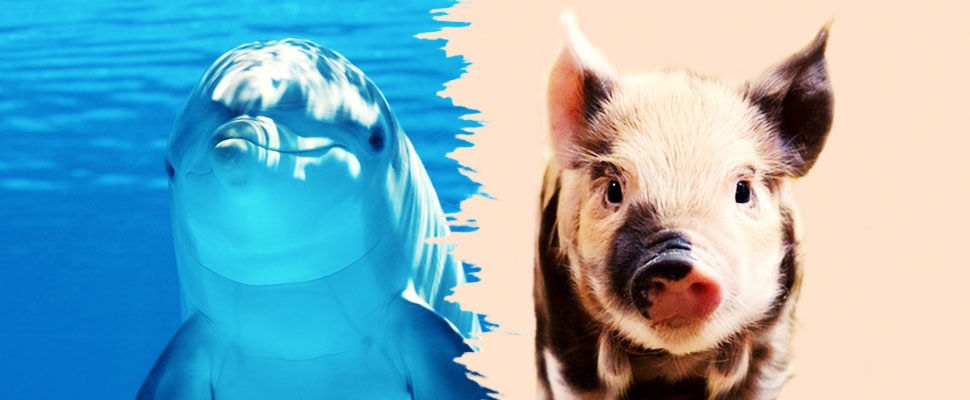Humans are not as different from animals as you think
Here we present some examples of animals that are similar to humans that maybe you already knew and others that will probably surprise you

A study published by the Society of Neuroscience states that the visual system of the barn owl is similar to that of humans. According to ScienceDaily, "the ability to perceive an object as distinct from a background is crucial for species that rely on vision to act on their environment. By grouping different elements of a scene IGNORE INTO "perceptual wholes" based on the similarity of their motion" is who humans achieve this, state the science news media. This is a characteristic shared by these two species, as suggested in the research, since the visual perception of both is similar.
Leer en español: Los seres humanos no son tan diferentes a los animales como se piensa
Humans are not as different from other species as you think. The barn owl is not the only non-primate animal that bears some resemblance to man. Here we present some examples that maybe you already knew and others that will probably surprise you:
Dolphin
The dolphin is perhaps the best example of animals that resemble humans. This marine mammal is characterized for being one of the few animals that have sexual intercourse not only during the ovulation period, assures The Huffington Post. Dolphins are also creatures with more than one sexual identity. According to the One Green Planet organization, "in an Australian-based study, scientists followed 120 dolphins for five years to take a closer look at dolphins’ social lives. They found that there are homosexual and bisexual relationships within the groups, with these relationships mainly happening between male dolphins."
Also, did you know that dolphins have a name? According to National Geographic, "past studies have shown that individual dolphins have a unique whistle, called a "signature whistle," that they often use in big group settings." With this whistle, the dolphins communicate and recognize each other, as several studies have shown that these social animals react to the whistles that are familiar to them. "The finding shows that signature whistles aren't just noises dolphins produce, but also signals to which they respond—a "fantastic contribution" toward understanding how dolphins communicate," explains Nat Geo.
Elephant
Elephants are mammals with a great sense of family unity and respect for their elders. According to a document by Elephant Without Borders on the similarities between elephants and humans, "both people and elephants have a complex social life and family structure. Both love, protect and nurture members of the family and educate the young ones with the skills and knowledge they need to survive." How to use tools is an example of this, a skill they learn thanks to the training they receive from their mothers or "other female guardians".
Like people, these big creatures live in groups in which there are hierarchies, so from a young age they learn to "know their place" within these social structures, is explained here. Elephants are also empathic because they can be "devastated by the death of one of their members," this document states. These are intelligent animals, with the ability to feel deep emotions. According to Caitlin O’Connell in an interview for Nat Geo about elephants in captivity, "elephant family reunions are amazing to see. The raw emotion exhibited in these greetings are awe-inspiring. And sometimes families will have just as intense a reunion after an hour or two of separation as they would after several days or longer. And it is particularly impressive to see how much attention is given to the matriarch by the other adult females."
Fun fact: apparently the elephants are the only animals, along with humans, who have chins, according to The Dodo.
You can also read: These are the most committed parents of the nature
Pig
Both the anatomy and the psychology of pigs is very alike to that of humans. Anatomically, these mammals have in common "the placement of organs (and often the size and function)," the skin and "certain progression of the disease," according to the Australian Academy of Science. Psychologically, pigs have been shown to be cognitively complex animals, explain Lori Marino and Christina M. Colvin in their article "Thinking Pigs: A Comparative Review of Cognition, Emotion and Personality in Their Domesticus."
These animals are very intelligent, they have a great spatial memory. In addition, they are very social, although they can be manipulative and competitive. They are also very playful and like to explore. Marino and Colvin explain that pigs participate in social games in which they fight, push and run one after the other, a behavior similar to that of a child. The most surprising thing? Pigs also discriminate, but through their noses.
Ant
It may surprise you, but the ant has many similarities with humans. According to La Nación, the ants "practice agriculture, have cattle and armies and capture slaves." In addition, this insect lives within a complex society, with social hierarchies and a sense of community. A society in which democracy exists, according to Daily Mail UK. The way they choose their new home is an example of this, according to the newspaper.
"Arizona State University studied a colony of Temnothorax rugatulus red ants, and noted that when they had to move, worker ‘scouts’ examined potential new homes. If they liked them, they returned to say ‘Follow me’, using pheromones (…). Then, a second ant would join the original and the process would be repeated, until a sufficient number approved the home", explains the media.
Latin American Post | Diana Rojas Leal
Translated from "Los seres humanos no son tan diferentes a los animales como se piensa"





